Best Practices For Treating Chronic Laminitis in Horses
Equine laminitis is a painful, debilitating condition, and in many cases, it is preventable. Laminitis is the inflammation of the soft tissues inside the horse’s hoof, which can lead to equine founder if the hoof bones shift, rotate, or sink. There are many types of laminitis, ranging from barely perceptible sub-clinical cases to long-term, chronic cases. There are many things horse owners can do to prevent and treat laminitis. Treating chronic laminitis presents its own set of challenges, which necessitate constant hoof care and effective environmental management to ensure horses remain comfortable.
Table of Contents
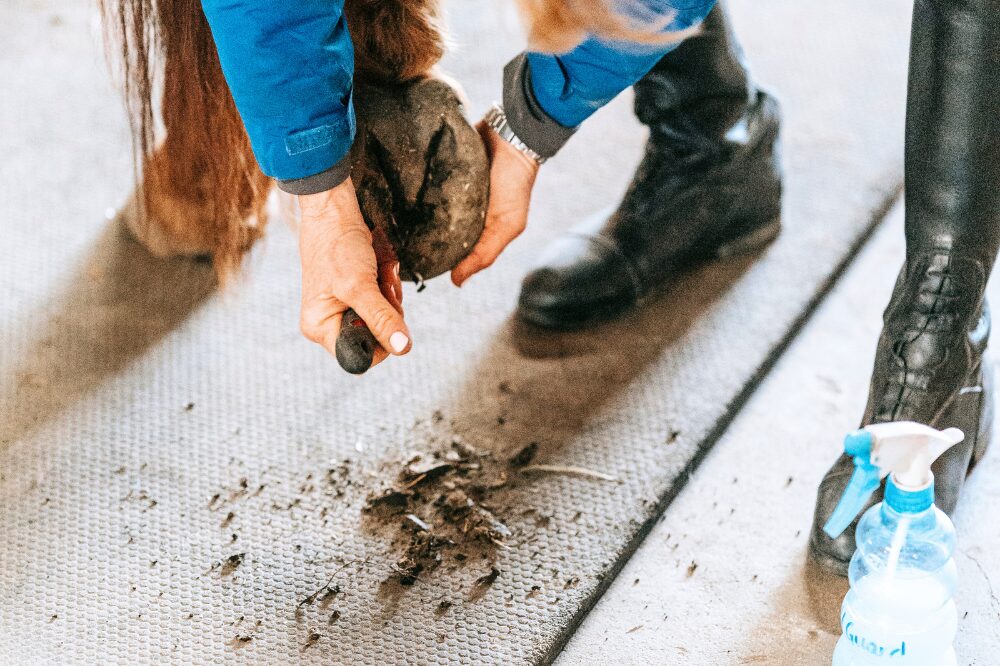
What is Laminitis?
- Inside the hoof, there are soft tissue structures called laminae that connect the bones inside the hoof to the hoof wall. The laminae are folded tissues, rich in blood supply, and create a link between the coffin bone, also called the pedal bone or P3, and the hoof wall. Laminitis is the inflammation of this tissue, which reduces blood flow, causes intense and unrelenting pain, and can contribute to the bones shifting out of place.
Laminitis vs. founder
- Laminitis and equine founder are two similar conditions, and the terms are often used interchangeably. Laminitis is the swelling of the laminae, and founder is the rotation and moving of the coffin bone inside the hoof. Horses can have laminitis but not founder. It’s a fine distinction, but note that both terms generally refer to the same thing.
Read this article about hoof anatomy to learn more about the structures affected.
Sub-Clinical, Acute, and Chronic Laminitis Differences
- There is no linear development of laminitis. Every horse is different, and horses with laminitis may fit into one of these categories, or all of them at some point. It’s also possible for a horse to have laminitis and never have another episode.
- The classification of laminitis into sub-clinical, acute, and chronic helps us understand the intensity of the pain and the duration of the laminitis. Each type of laminitis has some unique characteristics.
Sub-clinical laminitis in horses
- A horse with sub-clinical laminitis will not be obviously lame or show signs of pain. However, there is damage to the hooves. Think of this stage as the brewing stage, where the laminae change but without clear indications of hoof problems.
- There will be microscopic changes to the tissues in the hoof, which may or may not create acute or chronic laminitis in the future.
- Some horses may exhibit subtle signs of hoof pain, although these are often imperceptible without an expert eye and further diagnostic testing. You may see these signs of sub-clinical laminitis:
- Divergent growth rings on the hooves. These look like bands around the hoof.
- Stretched or separated white line near the toe. This situation may also be white line disease.
- Bruising in the toe/white line area. This may also be a stone bruise.
- Significant flares or dishing at the toe. Flares may also be indicative of nothing.
- Thin soles, which are often genetic and may not relate to laminitis at all.
- Changes in gait, such as a shortened stride or a tendency to toe-walk. These subtle changes in gait may be nearly invisible.
- Increased susceptibility to hoof abscesses.
- Coming in sore after grazing. Pasture grass can trigger laminitis in a few hours.
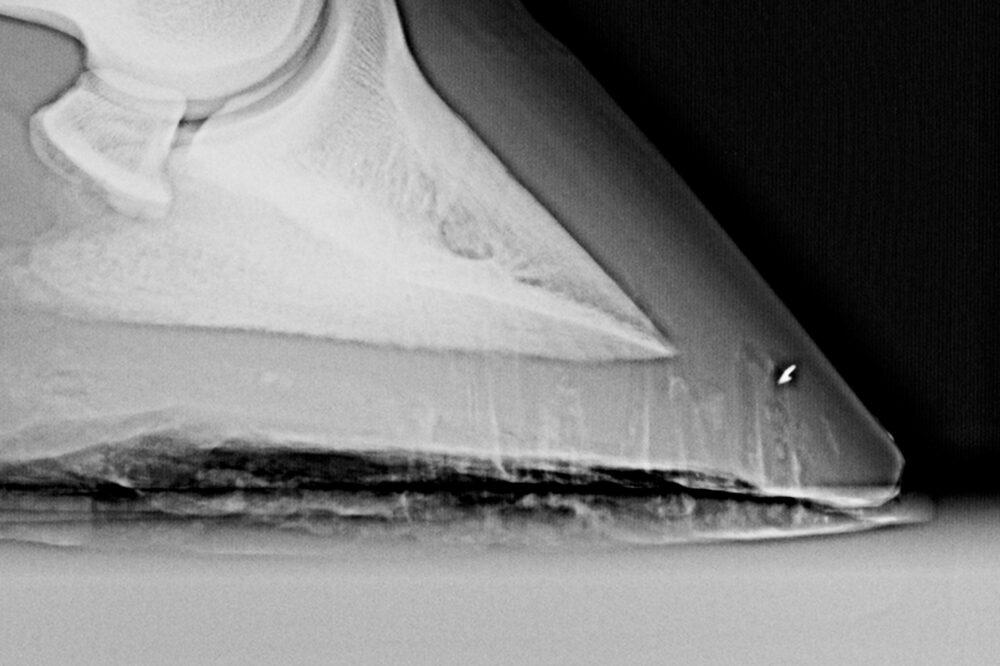
X-rays are critical for diagnosing hoof problems and tracking their healing.
Acute laminitis
- Acute laminitis is when you first see clear clinical signs in a horse, indicating pain. This stage can last anywhere from a few hours to a few days. Horses with acute laminitis often have strong pulses in the digital arteries near the fetlock. There can be swelling in the lower legs if related to black walnut shavings or trees. The hoof wall may feel hotter, and they can exhibit different levels of severe lameness and reluctance to move.
Some signs of acute laminitis are:
- Reluctance to walk or turn, especially onto harder surfaces or in smaller areas.
- Strong digital pulses.
- An increased heart rate at rest indicates pain.
- A reaction to hoof testers.
- Changes to the coronary band hair. As the structures inside the hoof change, the hair around the coronary band can start to point out or up.
- Hot hooves, although you’ll need to discern between hot hooves from swelling or from standing in the sun.
- Colic symptoms. Laminitis and equine colic often appear similar, and in some cases, they can occur simultaneously.
- Lethargy and a generally unhappy state.
- Showing the flehmen response. While typically a way to enhance scents, the flehmen response, or lip lifting, can also indicate pain.
- Excessive shifting of weight or not shifting weight at all.
- The leaning or rocking back stance is not as common as once believed. Your horse can demonstrate a normal stance during acute laminitis.
- Immediate veterinary care is required to help the horse showing any of these signs. Although it’s tempting to “wait and see,” by the time you notice these signs of pain, there is significant damage to the hoof.
Chronic laminitis
- When lameness due to changes to the laminae persists, a horse has chronic laminitis. Chronic laminitis can develop gradually over several months or result directly from an acute episode.
- Chronic laminitis lameness varies over time, with periods of pain-free recovery, episodes of severe pain, and everything in between.
Understanding Chronic Laminitis in Horses
- Chronic laminitis is more than just having lameness for an extended period. It means that the lamellar tissue and hoof wall become weaker and more damaged over time. With this chronic condition, you will notice clear physical changes in the horse that can impact their quality of life.
Definition and Overview of Chronic Laminitis
- Chronic laminitis is when there is long-lasting damage inside the hoof. It may also cause the pedal bone to move out of place within the hoof capsule. Constant inflammation, even low-grade inflammation, weakens the lamellar tissue over time.
- Proper care and management are crucial to minimize pain for your horse and prevent flares, where the pain and inflammation increase. This involves expert farrier care and sometimes corrective horseshoes, regular X-rays to monitor the placement of the coffin bone, and careful dietary management that includes a safe grazing protocol for some horses. Consistent monitoring of weight and metabolic disorders can also help reduce the likelihood of painful episodes.
Causes and Risk Factors for Chronic Laminitis
There are several causes of founder:
- Concussive forces, like road work, jumping on hard ground, and other short or long-term instances of impact with hard ground.
- Standing limb laminitis is the direct result of an injured leg shifting weight to the weight-bearing partner leg. Over days, weeks, or even months, the extra burden on the uninjured leg can create laminitis.
- Fever and inflammation, resulting from retained placentas, infections, or diseases like Potomac Horse Fever, can trigger laminitis. The systemic inflammatory response seen with severe systemic disease is intended to fight pathogens, but can create an episode of laminitis.
- Medications and toxins can create laminitis. Corticosteroids may instigate laminitis in some high-risk horses, and black walnut shavings or exposure to the tree create laminitis.
- Excessive carbohydrate consumption, or “gorging on grain,” happens when horses eat too many sugars and starches from grass pasture or the feed room. The digestion creates endotoxins that damage the laminae and may trigger permanent damage to the hoof.
- Metabolic disorders are the prevalent cause of laminitis in horses. Pituitary pars intermedia dysfunction (PPID, formerly known as Cushing’s disease in horses) and equine metabolic syndrome (EMS) interfere with healthy sugar create insulin dysregulation. Excessive insulin created by metabolic disorders leads to founder.
- All of these causes can lead to sub-clinical, acute, or chronic laminitis. Often, there is sub-clinical laminitis that builds over time. In other cases, an acute episode can linger for weeks, months, or even years. The hoof grows slowly, and damage can be permanent.
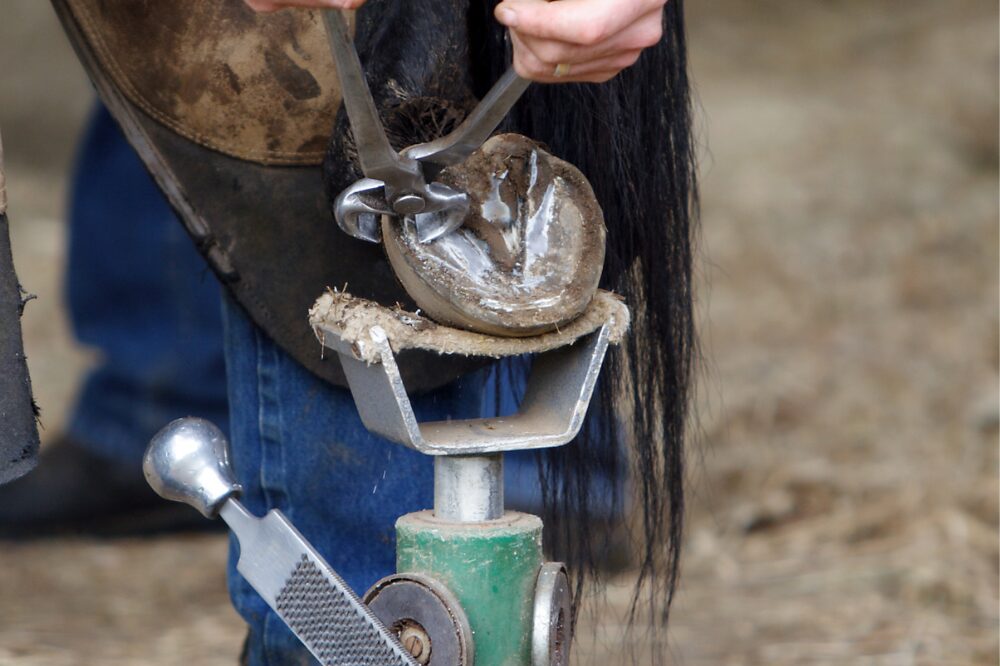
Your vet and farrier can develop a hoof care plan for recovery and comfort.
Recognizing Signs and Symptoms
- Even if your horse has never had an obvious case of founder, they can develop chronic laminitis. These warning signs are subtle and often need bloodwork, radiographs, and a keen eye to spot.
- This is a great time to reiterate that knowing your horse’s normal vital signs (temperature, pulse, and respirations) along with digital pulses can alert you to pain.
Clinical signs of chronic laminitis:
- Reluctance to walk on harder surfaces.
- Subtle changes to the walk. You may see toe-first walking.
- Resistance to going forward under saddle.
- A seemingly inconsequential change to the normal digital pulses and heart rate.
- Soreness after a farrier visit.
- Coming in from eating pasture with hot hooves or sore feet.
You will likely see these changes with chronic conditions:
- A change to hoof shape. This includes rings, distorted hoof wall growth, or a slipper foot appearance where the hoof is elongated and narrow, sometimes with a dish shape.
- Varying degrees of lameness or lameness that seems to ebb and flow.
- Increased occurrences of abscesses, hoof bruises, or weakening of the sole of the hoof.
- Upon X-rays, there may be subtle shifting of the coffin bone.
- Hoof cracks near the coronary band.
- White line disease as bacteria invade the widening gaps in the hoof wall.
Common Triggers and Underlying Conditions
- Many factors can contribute to the onset of chronic laminitis and the development of a treatment plan. Knowing the primary causes and factors makes management easier, as you can systematically make adjustments to feed, environment, and footing, as well as farrier care, vet care, and bloodwork, to keep your horse comfortable.
Endocrinopathic Laminitis (Metabolic Causes)
- The most common underlying cause of chronic laminitis is endocrinopathic laminitis. PPID and EMS can directly affect hoof health and potentially cause inflammation in the hoof capsule. While PPID links to a dysfunction of the pituitary gland that interferes with hormones, EMS is directly correlated to obese horses.
- All metabolic conditions can increase the risk of laminitis without your horse showing any outward signs of metabolic issues. You need your vet to help you track metabolic health with regular bloodwork and health checks.
The sugar and starch path to laminitis
- When horses eat sugars and starches, their small intestine does most of the digestion. But, with carb overload or grain/grass gorging, much of those sugars end up in the hindgut where microbes chow down. As a result, these hungry microbes upset the pH balance in the hindgut, creating endotoxins and a more permeable intestinal wall. Then, the endotoxins escape into the bloodstream and into the hoof.
- The added sugars also increase insulin, which can directly create laminitis. This chain reaction is why horses may come in from grass pasture with hot hooves or soreness.
- When a horse has a metabolic disorder, they are already producing too much insulin, making them more susceptible to sugar and starch overload, also called grain overload.
Mechanical and Traumatic Factors
- Mechanical and traumatic problems play a big part in how chronic laminitis starts. Injuries to one leg create to excess weight on the healthy leg. If your horse is obese, this compounds.
- Footing matters! Riding on hard ground sends a concussion through the hoof and leg. This is often called road founder. Standing in stalls or paddocks with rock hard ground also fatigues the legs and hooves.
- Injuries to the hoof, like bruises or abscesses, also create pain and weakened laminae.
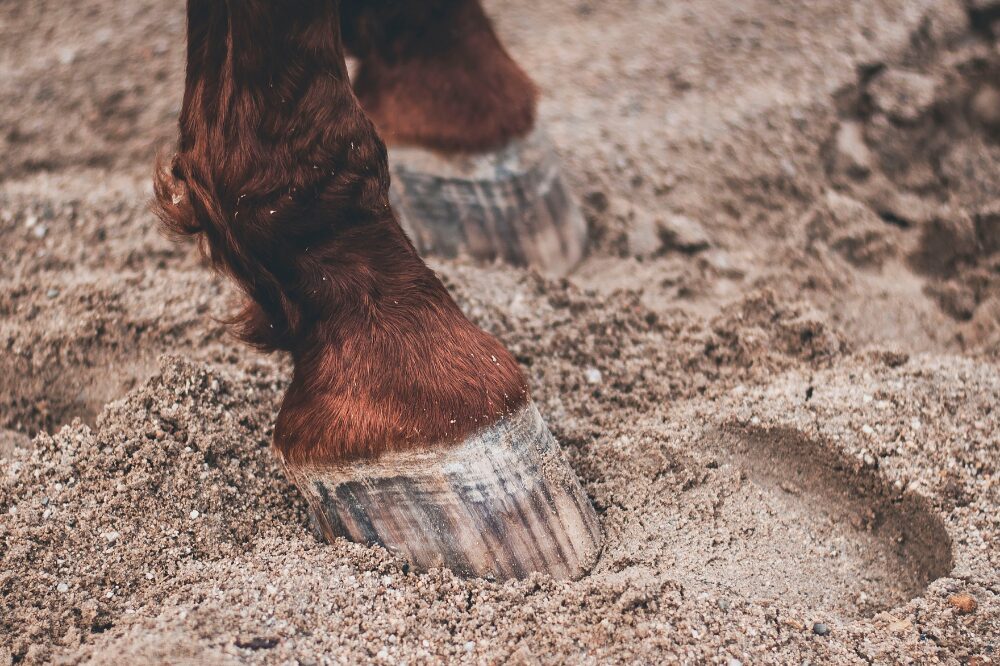
Soft ground can be best for sore hooves.
Diagnosing and Treating Chronic Laminitis
- Your vet can diagnose hoof problems, and your farrier helps to execute the treatment plan. This is why consulting your veterinarian for hoof problems is so crucial. Not only can your veterinarian diagnose the issue, they have radiographs to pinpoint problems and help your farrier with trimming and shoeing. Your vet can also test for metabolic disorders, help with a new diet, and prescribe medications for pain and metabolic support.
- Tracking progress is infinitely more accurate with your vet’s help. Regular checkups and X-rays monitor coffin bone placements and progress in healing. Moving forward, supportive care and management of your horse’s pain are the priority.
Clinical Examination and History
Your veterinarian examines many factors when evaluating your horse for lameness. There’s a physical exam, in which your vet might look at the following things and test your horse for soundness and hoof health:
- Digital pulses
- Vital signs – especially temperature and pulse rate to assess fevers and pain levels
- Hoof testers to narrow down locations of pain
- Walking, backing, turning
- How your horse shifts weight while standing
- Environmental cues like footing and bedding
- X-rays to see inside the hoof
- Your horse’s weight, age, fitness, and overall health
Your vet should also examine:
- Your horse’s diet, the NSC values of the feeds and forage you use, and what supplements you give.
- An assessment of the pasture grass and your horse’s grazing schedule.
- Metabolic health indicators, like weight, age, skin condition, previous history, and other signs of metabolic disorders. Regular bloodwork to check for insulin resistance and PPID is always a good idea, and critical for suspected founder.
Advanced Imaging Techniques
- There are two imaging techniques for the hoof that help your vet assess hoof health. Radiographs provide your veterinarian with a clear picture of the angles inside the hoof, revealing any signs of rotation. Because laminitis and founder often linger for months and years, it’s vital to have imaging to track progress and healing. It’s impossible to correctly guess what’s happening to the coffin bone without X-rays.
- Another useful imaging technique is the venogram. This technique involves injecting contrast into the hoof’s vasculature to visualize the blood flow. It’s fascinating to see the resulting map of the vessels in the hoof, and it gives your vet valuable information about the circulation in the hoof.
Read this article for more information about venograms.
Long-Term Therapeutic Strategies for Treating Chronic Laminitis
- It’s most likely that chronic laminitis results from metabolic disruptions to your horse’s body, and those are best managed with diet and lifestyle changes.
Equine nutrition changes to a low NSC value diet
- Stick to a forage-based diet for high-risk horses to minimize the risk of sugars and starches triggering an acute case or flaring up chronic hoof problems.
- This means low non-structural carbohydrate (NSC) values of 10-12% or less for everything your horse eats.
- Teff and Timothy hay are usually lower in NSC value than other hays, and for some horses, alfalfa is a good option for part of the diet.
- Commercial feeds and supplements should have the lowest NSC value available. Most often, this is a ration balancer and not a complete feed. Don’t rely on marketing that claims “low starch,” as that’s marketing and not a percentage value. Read the feed bag labels and contact the manufacturer for the exact number.
- Restrict or eliminate pasture grass. Grazing muzzles are wonderful tools to help your horse graze, move, and interact while lowering the volume and speed of sugars and starches your horse eats. Dry lots may be more appropriate for other horses.
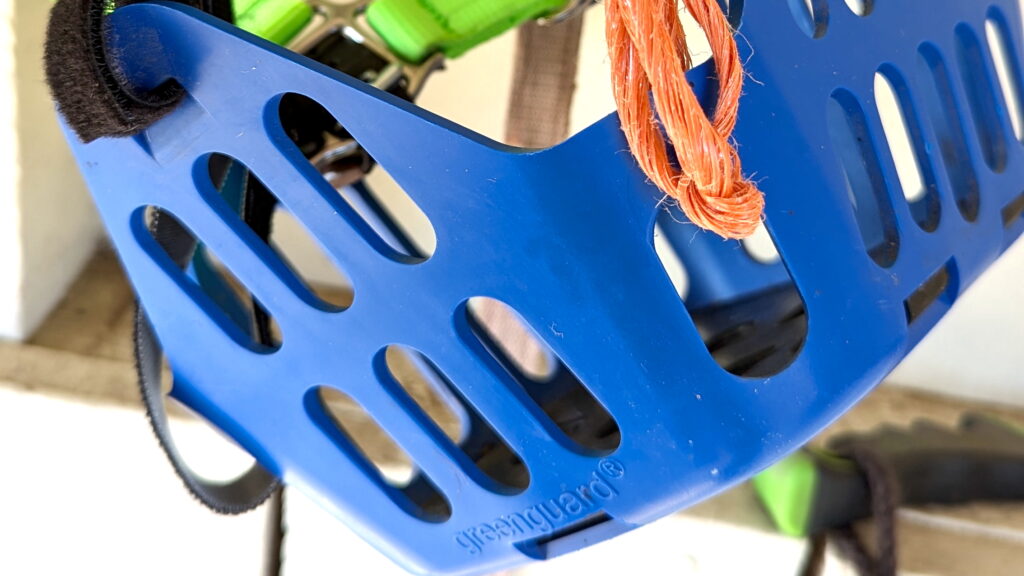
Grazing muzzles help at-risk horses have the benefits of grazing and play.
Supplements for metabolic health
- Many new supplements work to help regulate your horse’s metabolism. They are often delicious and easy to feed.
- Others, like hindgut buffers, help negate any changes to the hindgut pH if there is excessive sugar and starch consumption.
How To Support Your Horse’s Hoof Health and Rehabilitation
- Have you vet do regular bloodwork to monitor metabolic changes.
- Have your vet and farrier consult, with X-rays, about trimming and shoeing practices.
- Test your horse’s digital pulses daily. EVERY DAY.
- Give your horse options for footing. Add sand to paddocks, use mats for hard surfaces, and deep bedding in stalls.
- Use grazing muzzles for grass and slow feeders for long-stem forage.
- Only feed low-sugar treats, like hay cubes or hay pellets.
- Monitor your horse’s weight with a weight tape.
- Let your horse move. Appropriate exercise and plenty of turnout are key to keeping your horse’s brain and body moving soundly.
- Use anti-inflammatory medications and supplements only with your veterinarian’s advice, and be aware that they may mask signs of a more severe flare.
The most proactive thing you can do for your horse is monitor their metabolic health, long before you even think about treating chronic laminitis. An ounce of prevention (like bloodwork) can mean the difference between a healthy, long life and one filled with debilitating pain.
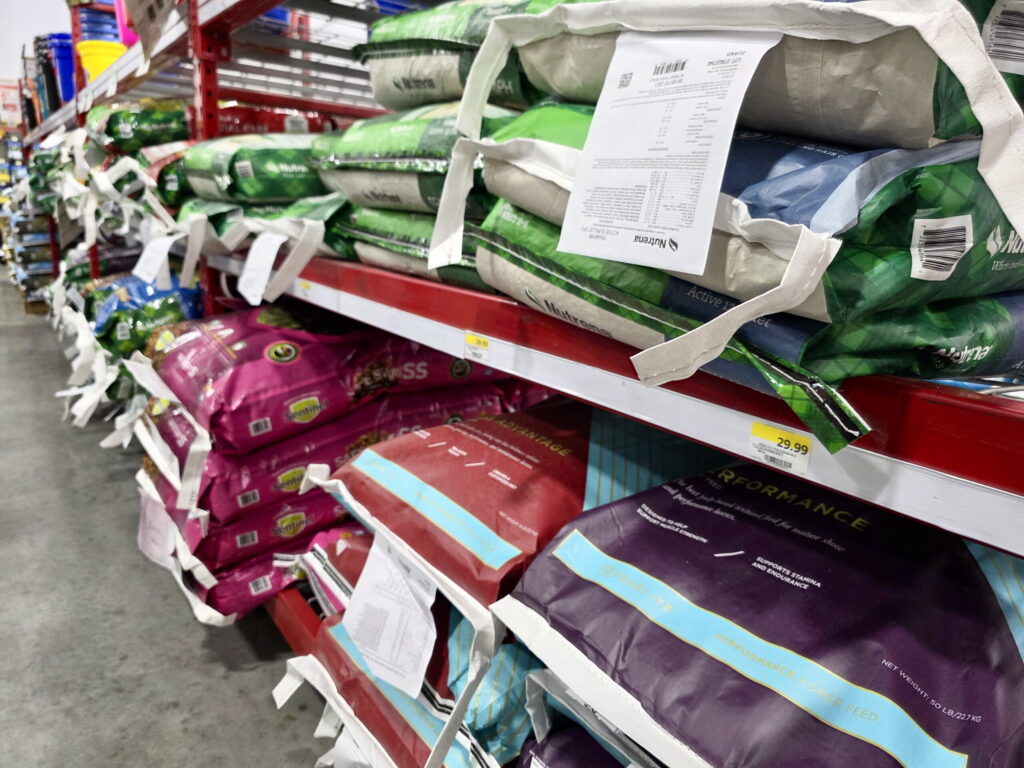
Feed your horse well for maximum hoof health!
Frequently Asked Questions About Chronic Laminitis
Can surgery help chronic laminitis and founder in horses?
There are surgical techniques to help relieve a horse’s pain during laminitis cases. In severe cases, a veterinarian can cut tendons attached to the distal phalanx (the coffin bone) to prevent the tension from rotating the tip of the coffin bone further. Surgical intervention is not always successful.
Can horses recover fully from chronic laminitis?
Yes, some horses with chronic laminitis can get better and have their hooves heal with the right care. Early diagnosis, x-rays, and proper farrier work, along with nutrition and diet changes, go far when treating chronic laminitis and give your horse the best chance at recovery.
What are the early warning signs of a relapse?
Early signs of a relapse in chronic laminitis may include increased hoof sensitivity, excessive heat in the feet, or changes in the digital pulse. You might also see changes in the way the horse stands or walks. Notice the circumstances as well, such as lush pasture grazing or weight gain.
Is it safe for a horse with chronic laminitis to be ridden again?
Some horses with chronic hoof problems like laminitis should not be ridden, but many make healthy recoveries and may return to some level of appropriate work. Together with a proper diet and preventative care, your horse may never have another episode.
How often should my farrier see a laminitic horse?
A horse with laminitis should see a farrier every four to six weeks or more, especially in the early stages of diagnosis. Working with the veterinarian and reviewing current hoof X-rays provides your farrier with the best information for effective trimming and, in some cases, shoeing.
When is it time to put a laminitic horse down?
Choosing to put down a horse with laminitis is difficult. Always consult your veterinarian and consider the quality of life. With persistent pain and hoof degeneration, effective pain management can be challenging, and normal activities become uncomfortable.
How long does it take for a horse to recover from founder?
Recovery from laminitis can vary significantly from one horse to another. In some cases, you may notice your horse showing improvement in a few weeks. For others, it can take many months or years with constant monitoring of hoof health and metabolic health.
Key Highlights
- Grasp the distinctions among sub-clinical, acute, and chronic laminitis in equines.
- Recognize key causes and clinical signs of laminitis for timely identification and intervention.
- Investigate diagnostic methods, including clinical examinations and advanced imaging techniques, to inform treatment decisions.
- Understand long-term strategies, such as therapeutic shoeing, dietary modifications, and exercise management.
- Track progress effectively by making adjustments to the treatment plan, with a focus on prevention and pain relief.
- Uncover answers to commonly asked questions about recovery outcomes, relapse symptoms, and modern treatment advancements.
Videos
Go Shopping
Stock up here for your horse supplies! As an Amazon Associate, I earn from qualifying purchases, but it’s ZERO extra cents to you. As a Walmart Associate, I earn from qualifying purchases as part of their affiliate plan. I appreciate your support! You can also visit my Amazon storefront here: PEG storefront.
This supplement helps high-laminitis risk horses and has calming ingredients like magnesium.
2 sizes of this slow-feeding hanging hay toy - snack size holds a few flakes, and the half size holds 1/2 bale. There's also an XL that ground feeds.
Use code 15PROEQUINE for sitewide savings on slow feeders and more.
This supplement for metabolic disorders is vet recommended and has science to back it up!










